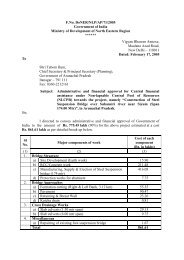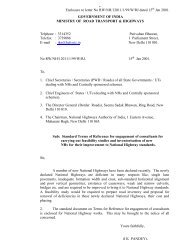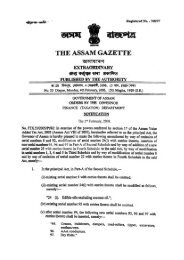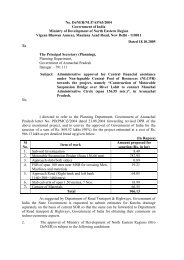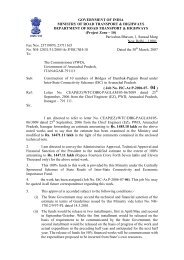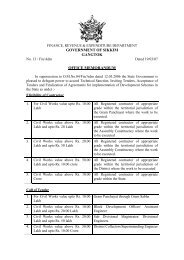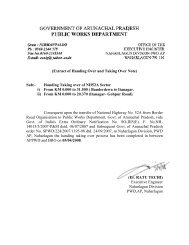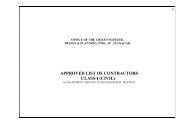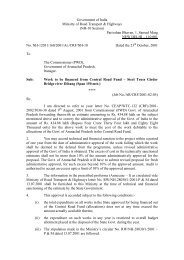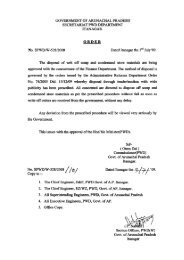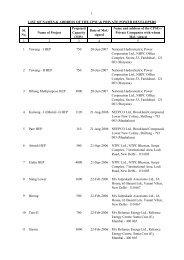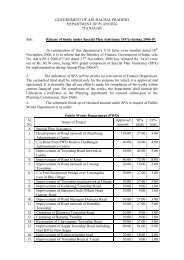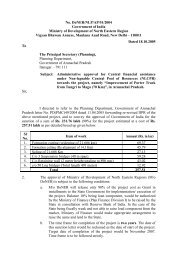GUIDELINES FOR ADMINISTRATION OF NON-LAPSABLE ...
GUIDELINES FOR ADMINISTRATION OF NON-LAPSABLE ...
GUIDELINES FOR ADMINISTRATION OF NON-LAPSABLE ...
You also want an ePaper? Increase the reach of your titles
YUMPU automatically turns print PDFs into web optimized ePapers that Google loves.
<strong>GUIDELINES</strong> <strong>FOR</strong> <strong>ADMINISTRATION</strong> <strong>OF</strong> <strong>NON</strong>-<strong>LAPSABLE</strong> CENTRAL POOL<br />
<strong>OF</strong> RESOURCES<br />
1. Background:<br />
1.1 The North Eastern Region (NER) comprises of eight States viz. Arunachal<br />
Pradesh, Assam, Manipur, Meghalaya, Mizoram, Nagaland, Sikkim and Tripura.<br />
The development concerns of these States are pursued through their respective<br />
Five Year and Annual Plans as well as those of the Union Ministries and Central<br />
Agencies. In addition, projects of inter-State nature in the Region are funded<br />
through by the North-Eastern Council (NEC), which has a separate additional<br />
budget for the purpose.<br />
1.2 The North East has essentially depended on Central funding for<br />
development works. All the States in the NER are Special Category States whose<br />
Development Plans are centrally financed on the basis of 90% Grant and 10%<br />
Loan. Further, the Special Category States are allowed to use up to 20% of the<br />
Central Assistance for Non-plan expenditure.<br />
1.3 Despite the fact that the per-capita plan outlays of the NE States over a<br />
period of time have increased yet States still rank significantly below the<br />
national average in so far as the development of infrastructure is concerned. In<br />
terms of per-capita, State Domestic Product or other development indices, such<br />
as Power, Length of Roads or Hospital Beds, the North-East ranks well below the<br />
national average. Though the literacy levels are higher than the national<br />
average, vocational training and entrepreneurial skills remain weak areas.<br />
1.4 As the benefits of economic development have yet to steadily accrue to<br />
the Region, efforts have been initiated in this direction in the recent past through<br />
various supportive measures. In October 1996, the then Prime Minister<br />
announced “New Initiatives for North Eastern Region” and stipulated that at least<br />
10% of the Budget(s) of the Central Ministries/Department will be earmarked for<br />
the development of North Eastern States. A preliminary exercise undertaken by<br />
the Planning Commission in consultation with the various Ministries/Department<br />
revealed that the expenditure on the North East by some Union Ministries during<br />
1997-98 fell short of the stipulated 10% of the GBS for that year. Planning<br />
Commission thereafter explored the possibility of creating a Central Pool of<br />
Resources for the North East out of the unspent amount of stipulated 10% of<br />
GBS to support infrastructure development projects in the North East. Certain<br />
Departments (e.g. Atomic Energy, Ocean Development) could be exempted,<br />
mainly for the reason that they might have little direct involvement in the<br />
Region.<br />
1.5 A proposal was mooted by the Planning Commission to the Cabinet for<br />
constitution of such a Central Pool of Resources. The Cabinet approved the<br />
approach, in principle, on 15th December, 1997, observing that the creation of<br />
the Central Resources Pool would require Parliamentary approval and would<br />
have to await constitution of the Twelfth Lok Sabha. The Central Pool therefore,<br />
could not be constituted in 1997-98.<br />
1.6 Following the Lok Sabha elections earlier in the year 1998, the matter<br />
relating to creation of the Central Pool of Resources was pursued in consultation<br />
with the Ministry of Finance. The Prime Minister convened a Meeting of the Chief<br />
1
Ministers of the North Eastern States on 8th May 1998 when, inter alia, it was<br />
indicated that a Non-lapsable Central Pool of Resources for the funding of<br />
specific projects in these States would be created. The relevant paragraph from<br />
the Prime Minister’s speech reads as under:<br />
“We are examining the feasibility of creating a Central Pool of<br />
Resources (CPR) which, in turn, will give critical additional support<br />
for an accelerated implementation of projects in the entire region.<br />
This pool, created from the unspent balance of the allocated<br />
expenditure of 10% of the budgets of the concerned Central<br />
Ministries, could well amount to around Rs.1500 crore annually.”<br />
1.7 This commitment of the Government was also reflected in the Speech of<br />
the Finance Minister while presenting the Union Budget for the year, 1998-99.<br />
The relevant paragraphs from the Budget Speech are reproduced below:<br />
“Furthermore, it has been decided that a non-lapsable Central<br />
Resources Pool will be created for deposit of funds from all<br />
Ministries where the plan expenditure on the North Eastern Region<br />
is less than 10 per cent of the total plan allocation of the Ministry.<br />
The difference between 10 per cent of the allocation and the actual<br />
expenditure incurred on the North Eastern Region will be<br />
transferred to the Central Pool, which will be used for funding<br />
specific programmes for economic and social upliftment of the<br />
North Eastern States.”<br />
1.8 Further, as part of the budget proposals 1998-99, it was announced that:<br />
“It has been decided that all Central Ministries/Departments should<br />
earmark at least 10% of their budget for specific programme of<br />
development in the North Eastern Region. To the extent of shortfall<br />
in the utilization of this provision by any Ministry/Department<br />
(except some exempted ones) according to this norm, the amount<br />
would be transferred to a new Reserve Fund in the Public Account<br />
titled ‘Central Resource Pool for development of North Eastern<br />
Region’. Presently, a token provision of Rs.1 crore is being made for<br />
transfer to the fund. In Budget 1997-98, such short provision was<br />
assessed to be about Rs.1,600 crore. A similar exercise for<br />
analyzing the provisions in Central Plan specific to the North<br />
Eastern Region in Budget 1998-99 would be carried out and the<br />
Resources Pool would be enhanced at Revised Estimates stage to<br />
the extent of shortfall from the 10% norm.”<br />
1.9 The Union Budget 1998-99 was voted and passed by Parliament. With that,<br />
the Non-lapsable Central Pool of Resources was constituted with approval of<br />
Parliament.<br />
2. Objectives:<br />
2.1 In the conference of Governors and Chief Ministers of the North Eastern<br />
States and Sikkim held in January 2000 at Shillong the Prime Minister stated the<br />
2
objectives of the Non-lapsable Central Pool of Resources. The relevant paragraph<br />
from Prime Minister’s Speech is:<br />
“My Government has also created a pool of non-lapsable funds for<br />
the North-East and Sikkim. This pool, meant for funding<br />
development projects in these States, will fill the resource gap in<br />
creation of new infrastructure, which is a top priority concern of the<br />
Union Government.…”<br />
2.2 The broad objective of the Non-lapsable Central Pool of Resources scheme<br />
is to ensure speedy development of infrastructure in the North Eastern Region<br />
by increasing the flow of budgetary financing for new infrastructure<br />
projects/schemes in the Region. Both physical and social infrastructure sectors<br />
such as Irrigation and Flood Control, Power, Roads and Bridges, Education,<br />
Health, Water Supply and Sanitation - are considered for providing support<br />
under the Central Pool, with projects in physical infrastructure sector receiving<br />
priority.<br />
2.3 Funds from the Central Pool can be released for State sector as well as<br />
Central sector projects/schemes. However the funds available under the Central<br />
Pool are not meant to supplement the normal Plan programmes either of the<br />
State Governments or Union Ministries/ Departments/ Agencies.<br />
3. Institutional arrangement to Administer the NLCPR Funds.<br />
3.1 There shall be a committee called ‘NLCPR Committee’ to administer<br />
NLCPR Scheme consisting of:<br />
(i) Secretary, Ministry of Development of North Eastern Region -<br />
Chairman<br />
(ii)<br />
(iii)<br />
Finance Secretary or his representative not below the rank of Joint<br />
Secretary-Member<br />
Home Secretary or his representative not below the rank of Joint<br />
Secretary -Member<br />
(iv) Secretary of the concerned Ministry/Department or his<br />
representative not below the rank of Joint Secretary proposing a<br />
central sector project - Member<br />
(v)<br />
(vi)<br />
(vii)<br />
Principal Adviser/ Adviser, In-charge of North Eastern State (and<br />
Sikkim) in Planning Commission. - Member<br />
Financial Advisor, Ministry of DONER -- Member<br />
Joint Secretary / Joint Secretaries In-charge of Non-lapsable<br />
Central Pool of Resources in the Ministry of Development of North<br />
Eastern Region – One JS being Member Convener<br />
3
3.2 The functions of the Committee are:<br />
(a)<br />
(b)<br />
(c)<br />
(d)<br />
To ensure equitable distribution of NLCPR resources amongst NE<br />
States keeping in mind existing inter-State and intra-State regional<br />
disparity, Human Development Indices (HDI) including per capita<br />
income, poverty level (BPL), density of infrastructure, population,<br />
area and terrain etc. besides performance of the States in<br />
implementing NLCPR projects.<br />
To assess projects/schemes proposed by the States of the NE and<br />
Sikkim under NLCPR in terms of viability and tangible socioeconomic<br />
impact.<br />
To prioritize them.<br />
To recommend allocation of funds for such schemes/projects.<br />
(e) To closely monitor and review the progress of the<br />
projects/schemes, including the deputation of appropriate officials<br />
of the Central Government, for field inspections on a periodic basis.<br />
(f)<br />
To suggest policy changes to obviate procedural and other<br />
bottlenecks in the execution of programmes/projects/schemes.<br />
3.3 The Committee would meet as often as necessary (at least once in two<br />
months) and would submit periodic recommendations to the Union Minister for<br />
Development of North Eastern Region on various aspects of NLCPR projects.<br />
3.4 Committee would be serviced by the NLCPR Division in the Ministry of<br />
Development of North Eastern Region.<br />
4. Project formulation under NLCPR<br />
4.1 The following process shall be adopted for project formulation:<br />
4.1 (i)<br />
(a) Each State would propose through its nodal Department, an<br />
Annual Profile of projects under the NLCPR in terms of a shelf of<br />
projects (called ‘priority list’ hereafter) latest by 30 th November<br />
for the next Financial Year. The submission date for Priority List<br />
of projects shall be strictly adhered.<br />
(b) Priority list once submitted shall not be changed or modified.<br />
(c) The priority list should be a comprehensive proposal<br />
containing ‘gap analysis’ of all major sectors and<br />
justification of the list of projects in fulfilling these gaps.<br />
This should be in consonance with the overall planning<br />
process within the State covering Annual Plans and Five<br />
year Plans.<br />
4
(d) States may identify certain sectors for focused<br />
investments with a long-term vision instead of expending<br />
these funds into small, diverse and stand-alone projects.<br />
(e) The State should also indicate that these projects have not<br />
been taken up or proposed to be taken up with any other<br />
funding mechanism.<br />
(f) Projects in backward areas/ Sixth Schedule areas/ Autonomous<br />
District Councils of the State would continue to be accorded<br />
weightage. While posing projects for funding under NLCPR in a<br />
particular financial year, the States may include projects from<br />
backward areas/ Sixth Schedule Areas/ Autonomous District<br />
Councils in the priority list of projects for a particular financial<br />
year minimum upto 25% of total cost of projects included in the<br />
priority list for that year.<br />
(g) Along with Priority List, the Concept Paper for each project<br />
included in it should be submitted denoting approximate financial<br />
outlay benefits accruing from such projects, identification of<br />
beneficiaries etc. (Details of model concept paper at Annexure-<br />
I). Any project contained in the Priority List without proper<br />
Concept Paper will not be considered.<br />
(h) Concept Papers must be prepared as per the generic structure at<br />
Annexure-I. They must clearly indicate a detailed analysis of<br />
the existing facilities in the sector and full justification for<br />
retention of the particular project. The Concept Paper must<br />
invariably delineate the cost-benefit analysis of the project. For<br />
economic sector project economic benefit should specifically be<br />
indicated comparing it with the cost involved.<br />
(i) The concept paper should inter-alia include a certificate<br />
that the project have not been taken up or proposed to be<br />
taken up with any other funding mechanism.<br />
(j) Government of India norms for projects and for the sector to<br />
which the project belongs should invariably be kept in mind while<br />
proposing a project.<br />
(k) Only the infrastructure development projects that may lead to<br />
socio economic upliftment in the State and having impact on<br />
larger number of people should be included in the list. No<br />
individual beneficiary schemes / projects should be included in<br />
the Priority List.<br />
(l) For optimum utilisation of funds, the States may propose<br />
the projects on the basis of present needs and keeping<br />
view the future expansions rather than making imaginary<br />
proposals.<br />
5
(m) To eliminate any duplication, the projects which can be taken up<br />
under the other schemes of Central Ministries or under the State<br />
Plan should not be included in the Priority List.<br />
(n) Projects with an estimated cost of only Rs.3.00 crore or above<br />
should be included in the priority list.<br />
(o) If a project in the priority list is considered by the NLCPR<br />
Committee but not retained, then it may not be proposed<br />
again at-least for next three (3) yrears.<br />
4.1 (ii) The cost indicated in the Concept Paper should be on realistic side<br />
and based on latest SOR. The cost escalation while finally sanctioning the<br />
project is allowed only to the extent of 10-15 % over the cost indicated in<br />
the Concept Paper. Under exceptional circumstances this limit can be<br />
extended up to 20% beyond which the project will stand chances of being<br />
dropped or the State Government will be required to comment and fund<br />
the enhanced cost.<br />
4.1 (iii) The scope of the project indicated in the Concept Paper<br />
should be what is intended to be reflected in the DPR. There should not be<br />
any major change in scope of project in DPR against what was proposed in<br />
the Concept Paper.<br />
4.1 (iv) Following criteria would further guide the project<br />
identification exercise by the NLCPR Committee:<br />
a. Projects of less than Rs.3 Crore would not be generally<br />
funded;<br />
b. NLCPR funds will not be used to fund land acquisition costs;<br />
c. Each location specific project would be counted as one; the<br />
practice of clubbing many projects into one to increase the<br />
size of the project would not be acceptable;<br />
d. Project acceptance would depend on its soundness. The State<br />
priority list will only be a suggestive guide. NLCPR Committee<br />
will not be bound by that priority.<br />
e. Projects in backward areas/ Sixth Schedule areas/<br />
Autonomous District Councils of the State would be given<br />
weightage and minimum 25% funds may be allocated to the<br />
projects falling in these areas.<br />
f. NLCPR funds would be an additionality to ongoing<br />
programmes. They would not be used to substitute a<br />
budgeted ongoing project or scheme. Emphasis need to be<br />
given for employment generation and infrastructure<br />
schemes;<br />
6
g. Normally a project duration should not exceed maximum 3-4<br />
years. Long gestation projects will not be encouraged;<br />
h. Funding under NLCPR would be made available to<br />
State/Central agencies only. The State however, may decide<br />
to get the project implemented through any qualified,<br />
reputed, experienced agency to be specified in the proposal.<br />
4.1 (v)<br />
a) The Detailed Project Reports (DPRs) would be prepared properly by<br />
the State Department concerned as per generic structure given at<br />
Annexure II, based on the current schedule of rates and<br />
submitted to the Ministry of DoNER, in five (5) copies, through<br />
Nodal Department of the State within two months of retention of<br />
projects. If the State Government could not submit DPR of<br />
the project within two (2) months of its retention the project<br />
may be dropped.<br />
b) To avoid the repetition of mistakes while preparing DPRs, the State<br />
Governments should refer to the comments provided earlier by the<br />
Line Ministries/ Ministry of DoNER for improvement in the DPRs of<br />
similar type of projects.<br />
c) All regulatory and statutory clearances like forest & environment,<br />
land acquisition etc. should be identified and timeframe for<br />
obtaining the same has to be indicated.<br />
d) The DPR should be accompanied by a socio-economic feasibility<br />
report and must establish its economic and technical viability such<br />
as its rationale, cost, finances available from other sources, similar<br />
facilities available in and around area of the project site, detailed<br />
technical specifications etc.<br />
• CPM and PERT chart;<br />
• Year-wise phasing of inputs, viz. expenditure;<br />
• Quarterly and yearwise physical outputs/targets to be<br />
achieved (as project monitoring indicators);<br />
• Project Implementation Schedule (Annexure III);<br />
• An authentication by State Authorities (not below the<br />
level of Chief Engineer equivalent) that the costs are<br />
based on the latest Schedules in vogue in the State<br />
concerned;<br />
• All relevant regulatory and statutory clearances and time<br />
frame for obtaining the same.<br />
4.1 (vi) Central Ministry/Department would submit projects for funding<br />
under NLCPR only if they have exhausted the funds (minimum 10 percent<br />
of their Budget) provided for NER. Even there, they would be encouraged<br />
to take recourse, in the first instance, to supplementary demand for<br />
grants for augmentation of their budgets for projects in NER. Further, in<br />
case of projects of central ministries/departments, the projects should<br />
7
have all the necessary SFC/EFC clearances. (Proposals related to state<br />
sector projects will not require EFC/SFC routing since the assets are not<br />
created in the central government, the assistance is on 90% grant basis<br />
on which the state plan funds are also transferred). The proposals from<br />
the Central Agencies however will require such clearance and should be<br />
routed through the concerned Administrative Ministry/ Department. The<br />
NLCPR 100% grant will be made available only for that year and the<br />
Ministry/Department should take up the remaining part of the project<br />
from next year in their annual plan.<br />
4.1 (vii) Occasionally, proposals may be taken up directly by the NLCPR<br />
Committee for strategic or other priority reasons. These proposals would<br />
also be treated as being duly submitted, and scrutinized for<br />
eligibility/desirability as if State Government/Union Ministries concerned<br />
had submitted them. This may also include strategic intervention through<br />
Corporations / Organisations under the administrative control of the<br />
Ministry of DONER and also for monitoring / evaluation studies etc., of<br />
NLCPR projects. These proposals will receive 100% funding from NLCPR.<br />
4.1 (viii) No staff component – either work charged or regular – shall be<br />
created by the project implementing authorities from NLCPR funds. All<br />
such requirement should be met from redeployment of surplus manpower<br />
in the department.<br />
4.1 (ix) No maintenance work/ cost will be funded from NLCPR funds.<br />
4.1 (x) The Projects which are not retained by NLCPR Committee in<br />
any financial year can also be considered in the subsequent year only if<br />
the concerned State Government feels that the project is of vital<br />
importance to economic / social development of the State and thus be<br />
included in the subsequent priority list.<br />
5. Appraisal of Project Proposals<br />
5.1 The Member Secretary will place the shelf of priority project proposals<br />
before the NLCPR Committee.<br />
5.2 The Committee in the first instance would identify the projects out of the<br />
shelf, which can be considered for funding based on the soundness of the<br />
proposal for further detailed examination. If required prior consultation may<br />
be made with State Government officers/ Chief Secretaries.<br />
5.3 All Recommendations of the NLCPR Committee would be placed before<br />
Minister, Ministry of Development of North Eastern Region for his approval<br />
before being communicated to the States for submission of DPRs.<br />
5.4 The exercise of retention of projects may be completed within one month<br />
of submission of Priority Lists by State Governments.<br />
5.5 The complete and proper DPRs of the retained projects received from the<br />
State Governments would be examined from technical and economic angle by<br />
the Technical Wing of the Ministry/ Central Ministries concerned/ CPSU selected<br />
8
for the purpose. The Technical Wing of the Ministry/ Central Ministries<br />
concerned/ CPSU will offer their comments on the DPR within 15 days and final<br />
comments within one month of receipt of DPR. The comments of the Technical<br />
Wing of the Ministry/ Central Ministries concerned/ CPSU selected for the<br />
purpose would be conveyed immediately to the State Governments. Similarly<br />
the State Government fully complying with the comments of the Ministry should<br />
send back the DPR/ revised DPR along with compliance report within 15 days<br />
from the receipt of the comments of the Ministry. If required the Ministry may<br />
invite officers of the State Government for clarifications.<br />
5.6 To avoid duplication of projects the DPRs may be sent to Planning<br />
Commission and Central Ministries concerned to obtain their comments<br />
within a definite time frame of one month about duplicity in funding of<br />
projects. If no comments received within one month, the Planning<br />
Commission and Central Ministries concerned may be deemed to have<br />
no objection in funding the project under NLCPR and DoNER may<br />
proceed for according sanction.<br />
5.7 Project proposals techno-economically cleared by the Technical Wing of<br />
the Ministry/ Central Ministries concerned/ CPSU selected for the purpose would<br />
be put up before the NLCPR Committee for final approval. This process would be<br />
completed within two months of the receipt of complete and proper DPR in the<br />
Ministry from the State Government.<br />
5.8 Concurrence of the Minister DONER would be obtained before according<br />
final approval for the projects to be funded under NLCPR.<br />
6. Cost escalation<br />
6.1 The proposal relating to escalation in cost of the sanctioned projects for<br />
any reason generally does not qualify for consideration under the Non-lapsable<br />
Central Pool of Resources. However, in some deserving cases, if the<br />
enhancement of the cost is due to change in scope of the works that was not<br />
envisaged at initial stage, the proposal will be submitted to the NLCPR<br />
Committee at the appropriate juncture for consideration.<br />
6.2 In cases where the increase in cost is not due to change in scope, and felt<br />
to be justified due to factors beyond the control of the executing agency, NLCPR<br />
Committee will take a view provided that in such cases in overall terms the<br />
escalation does not exceed 20% of the originally approved cost. Financing of<br />
such increased cost may be permitted on the basis of sharing between the Nonlapsable<br />
Central Pool of Resources and the State Government in the ratio of 1:1.<br />
7. Project implementation by the State Government.<br />
7.1 Once the project is approved by the Ministry of DoNER the State<br />
Government should ensure that the tender has been called on competitive basis<br />
by giving wide publicity in print media & website etc. and the works have been<br />
awarded within three months of its sanction, even without waiting for the<br />
release of funds from State Government to implementing agency.<br />
9
7.2 The State Government should follow all codal formalities and strictly<br />
adhere to the project implementation schedule and physical targets given in the<br />
DPR.<br />
7.3 State Government may give preference to Local Bodies for<br />
implementation of the projects if they are qualified under tendering/<br />
financial rules followed by them.<br />
7.4 Any project which could not be completed within target date (as given in<br />
DPR by the State Government) plus six months, it will be closed for funding by<br />
M/o DoNER. The State Government will be responsible for completion of the<br />
balance work in the project from its own resources.<br />
7.5 In case during implementation of project State Government wants to<br />
increase/ change the completion schedule of the project, it may be done at the<br />
level of State Chief Secretary by holding a meeting and the revised date of<br />
completion so finalized may be conveyed to Ministry of DoNER with specific<br />
reasons well before the expiry of six months period after the original/actual date<br />
of completion.<br />
8. Release of funds<br />
8.1 Once the proposal is approved for support by the Ministry of DoNER the<br />
funds would be released in three installments comprising of 40%, 40% and<br />
20% of the approved project support/cost unless there are special<br />
circumstances which would be clearly brought out in the proposal for release.<br />
The NLCPR division through the Joint Secretary concerned shall obtain the<br />
concurrence of Internal Finance Division of the Ministry for releasing<br />
installments.<br />
8.2 The funds would be released/ sanctioned to the State Government in the<br />
form of 90:10. 90% of the approved cost would be released by the M/DoNER as<br />
Grant. Balance 10% being State share would be contributed by the State<br />
Government. As regards the disbursements, if any for projects of Union<br />
Ministries/Departments, it shall be made from the Central Pool to the<br />
department/ministry in form of supplementary demand for grants.<br />
8.3 Release of funds for ongoing projects: The 2 nd installment will be released<br />
only on completion of 40% of the project and submission of utilization certificate<br />
of at least 80% of funds released in 1 st installment. The subsequent installments<br />
shall depend upon the progress - both in financial and physical terms – of the<br />
implementation of the project subject to 80% utilization of funds of last release,<br />
and full utilisation of all prior releases, if any, and achieving commensurate<br />
physical progress.<br />
8.4 Request for release of subsequent installments of funds submitted by the<br />
State must be accompanied with:<br />
• Utilization Certificates (UCs)<br />
• Quarterly Progress Reports (QPRs)<br />
• Photographs of the works completed<br />
10
• Work plan for the requisitioned amount with milestones and time<br />
frame<br />
• Inspection report of Nodal officer indicating the physical & financial<br />
progress of the project, etc.<br />
8.5 UCs shall be submitted in the prescribed proforma (Annexure IV) only<br />
when the expenditure on the project has been incurred by the implementing<br />
agency. Planning Secretary on behalf of the State and, in case of a Union<br />
Ministry, an officer not below the rank of Joint Secretary, should sign the UCs.<br />
Release of further installments shall be recommended only after receipt of UCs<br />
and QPRs and other mandatory documents.<br />
8.6 Funds released from the Pool must be transmitted to the implementing<br />
agency/ project authority (such as PWD, Housing Corporation, State Electricity<br />
Board, etc.) by the State Government within 15 days from the date of release of<br />
funds from Government of India and a certificate to this effect be sent to<br />
Ministry of Development of North Eastern Region by the State Planning<br />
Department.<br />
8.7 Funds released by the Government of India must be utilized within a<br />
period of 12 months from the date of release. In case the funds are not utilized<br />
within the stipulated time, such cases may be referred to the Ministry of<br />
Development of North Eastern Region with sound reasoning for revalidation.<br />
Revalidation for a limited period may be granted by Secretary of Ministry of<br />
DONER on merit.<br />
9. Monitoring & Evaluation<br />
9.1 The State and Union Ministries/Departments shall report the progress in<br />
respect of each project at the end of the quarter on the proforma (QPR)<br />
prescribed for this purpose at Annexure V. Any additional information may be<br />
furnished along with the format. Such QPRs should reach the Joint Secretary of<br />
the Ministry within three weeks of the end of the quarter under report.<br />
9.2 Chief Secretary of the State shall hold quarterly meeting to review the<br />
progress of implementation of the ongoing projects under NLCPR and make<br />
available summary record of such meetings to the Ministry of DONER.<br />
9.3 State will carry out project inspection periodically. The quarterly review<br />
report of the State would contain a separate and distinct section on the findings<br />
of the project inspection. In case of NLCPR projects implemented by Central<br />
Government agencies, such inspections may be conducted by their competent<br />
authority and reports will be submitted to the Ministry under intimation to<br />
concerned State Government.<br />
9.4 State would nominate a ‘nodal officer’ for each project who would be<br />
responsible for project implementation and monitoring.<br />
9.5 Monitoring and evaluation of implementation of the project shall also be<br />
undertaken through field inspections by officers of the Ministry of DONER, as<br />
well as through impact studies, social audits and evaluations conducted by<br />
11
government or through independent agencies at the request of the Ministry<br />
(DONER).<br />
9.6 Each State would ensure that the projects being funded under NLCPR are<br />
shown at Major-head to sub-head level in their plan budgets so that withdrawals<br />
from those heads as certified by audit can be matched with expenditure figures<br />
supplied by State for each project.<br />
9.7 The State Government would ensure that the data entry of the progress of<br />
the project starting from the submission of the priority list by the State<br />
Government upto the completion of the project shall be made by the designated<br />
officials of the State Government on the online data entry Management<br />
Information System (MIS) already in vogue.<br />
9.8 The Ministry should also review of implementation of projects with State<br />
Governments through video conference at the level of Joint Secretary.<br />
10. Transparency and Publicity of Information<br />
In order to ensure that the information about developmental schemes being<br />
financed through the Non-lapsable Central Pool of Resources reaches the<br />
ultimate beneficiaries, i.e. the targeted beneficiaries, there is a need to ensure<br />
greater transparency and publicity of information. For this purpose, the following<br />
shall be ensured:<br />
(i)<br />
All the schemes/projects being supported from the Central Pool<br />
shall be given wide publicity in local media.<br />
(ii) Immediately after project approval is received, the State<br />
Government shall display at project site a board indicating the date<br />
of sanction of the project, likely date of completion, estimated cost<br />
of the project, source of funding i.e. Non-lapsable Central Pool of<br />
Resources (Government of India), contractor(s) name and the<br />
physical Target as at Annexure-VI. After completion of projects,<br />
State Government will put a permanent display on site like plaque<br />
on the wall etc. after asset is created displaying details of NLCPR<br />
funding as per Annexure-VI.<br />
(iii)<br />
State Government shall disseminate information through media,<br />
print, electronic, through appropriate means on the schemes being<br />
implemented from the Central Pool.<br />
****<br />
12
ANNEXURE-I<br />
MODEL CONCEPT PAPER<br />
The following points may be kept in view while formulating the concept papers for<br />
priority projects for submission to Ministry of Development of North Eastern Region:<br />
1) The concept paper should elaborate the problem to be addressed through the<br />
project at the local / state level. Evidence regarding the native and magnitude of<br />
the problems should be given. Clear evidence should be available regarding the<br />
nature and magnitude of the problem to be addressed.<br />
2) The development objectives proposed to be achieved should be given.<br />
3) Benefits likely to accrue quantified in terms of population and other<br />
parameters.<br />
4) The ongoing initiatives taken by the State Government and the manner in<br />
which duplication will be avoided and synergy created through the proposed<br />
project.<br />
5) Economic parameters be given to justify the project for funding and in case of<br />
social infrastructure projects socio-economic analysis justifying taking up of<br />
the project may be elaborated.<br />
6) Issues relating to sustainability, including operation and maintenance of assets<br />
after project completion and related issues should be given.<br />
7) Estimated cost, financial and physical phasing, time frame, status of<br />
administrative and statutory clearances from State / Central Government<br />
authorities, and readiness for implementation of the projects should also be<br />
given.
GENERIC STRUCTURE <strong>OF</strong> THE DETAILED PROJECT REPORT (DPR)<br />
Annexure-II<br />
Context/background: This section should provide a brief description of the sector/subsector,<br />
the State priority, strategy and policy framework as well as brief description of the<br />
existing situation.<br />
This section should also provide:<br />
1. The sectoral policy of the State for the sector to which the proposed project<br />
belongs.<br />
2. If no sectoral policy is there, then the vision of the State Government in this<br />
regard should be given.<br />
3. Has the State Govt prioritized the works in this particular sector as per their<br />
importance/requirement<br />
4. Detailed facts and figures for that sector and the rationale for the particular project<br />
should be provided why this project should be chosen over other works in the<br />
same sector.<br />
5. How does this project justify to be given priority leaving behind other sectors<br />
6. Does this have some strategic importance for this state<br />
Problems to be addressed: This section should elaborate the problems to be addressed<br />
through the project/scheme at the local/regional level. Evidence regarding the nature and<br />
magnitude of the problems should be presented, supported by baseline data/surveys/reports.<br />
Clear evidence should be available regarding the nature and magnitude of the problems to be<br />
addressed. In addition this section should also include:<br />
1. How the project dovetails into the long-term sectoral policy of the State<br />
2. What are the existing benchmarks<br />
3. Benefits expected to accrue after completion of the project<br />
Project Objectives: This section should indicate the Development Objectives proposed to<br />
be achieved, ranked in order of importance. The deliverables/outputs for each Development
Objective should be spelt out clearly. This section should also provide a general description<br />
of the project.<br />
Target beneficiaries: There should be clear identification of target beneficiaries.<br />
Stakeholder analysis should be undertaken, including consultation with stakeholders at the<br />
time of project formulation. Options regarding cost sharing and beneficiary participation<br />
should be explored and incorporated in the project. Impact of the project on weaker sections<br />
of society, positive or negative, should be assessed and remedial steps suggested in case of<br />
adverse impact.<br />
Project beneficiaries: This section should present an analysis of alternatives strategies<br />
available to achieve the Development Objectives. Reasons for selecting the proposed<br />
strategy should be brought out. Involvement of NGOs should be considered. Basis for<br />
prioritization of locations should be indicated (where relevant). Options and opportunity for<br />
leveraging government funds through public-private partnership must be given priority and<br />
explored in depth.<br />
Legal Framework: This sector should present the legal framework within which the project<br />
will be implemented and strengths and weakness of the legal framework in so far as it<br />
impacts on achievement of project objectives.<br />
Environmental impact assessment: Environmental impact assessment should be<br />
undertaken, wherever required and measures identified to mitigate adverse impact, if any.<br />
Issues relating to land acquisition, diversion of forestland, rehabilitation and resettlement<br />
should be addressed in this section.<br />
On-going initiatives: This section should provide a description of ongoing initiatives and<br />
the manner in which duplication will be avoided will be avoided and synergy created<br />
through the proposed project.
Technology issues: This section should elaborate on technology choices, if any, evaluation<br />
of options, as well as the basis for choice of technology for the proposed project.<br />
Management arrangements: Responsibilities of different agencies for project management<br />
and implementation should be elaborated. The organization structure at various levels as<br />
well as monitoring and coordination arrangements should be spelt out. Simultaneously this<br />
section should include following information:<br />
1. The project implementation and monitoring arrangement<br />
2. Nodal officer<br />
3. Implementation team<br />
4. Implementation schedule<br />
5. Status of readiness of the project for execution indicating the status of availability<br />
of administrative and regulatory clearances such as:<br />
(a) Forest clearance<br />
(b) Acquisition of land<br />
(c) Any other clearance required etc. This Chapter will also list out<br />
monitoring arrangement proposed.<br />
Means of Finance and Project Budget: This section should focus on means of finance,<br />
evaluation of options, project budget, cost estimates and phasing of expenditure. Options for<br />
cost sharing and cost recovery (user charges) should be considered and built into the total<br />
project cost. Infrastructure projects may be assessed on the basis of the cost of debt finance<br />
and the tenor of debt. Options for raising funds through private sector participation should<br />
also be considered and built into the project cost.<br />
Time frame: This section should indicate the proposed 'zero' date for commencement and<br />
also provide a PERT/CPM chart.
Risk analysis: This section should focus on identification and assessment of project risks<br />
and how these are proposed to be mitigated. Risk analysis could include legal / contractual<br />
risks, environmental risks, revenue risks, project management risks, regulatory risks, etc.<br />
Evaluation: This section should focus on lessons learnt from evaluation of similar projects<br />
implemented in the past. Evaluation arrangements for the project, whether concurrent, midterm<br />
or post-project should be spelt out. It may be noted that continuation of<br />
project/schemes from one plan period to another will not be permissible without an<br />
independent, in depth evaluation being undertaken.<br />
Success criteria: Success criteria to assess whether the Development Objectives have been<br />
achieved should be spelt out in measurable terms. Base-line data should be available against<br />
which success of the project will be assessed at the end of the project (Impact assessment).<br />
In this regard, it is essential that base-line surveys be undertaken in case of large,<br />
beneficiary-oriented projects.<br />
Success criteria for each Deliverable/output of the project should also be specified in<br />
measurable terms to assess achievement against proximate goals.<br />
Financial and economic analysis: Financial and economic analysis of the project may be<br />
undertaken. This analysis should clearly be able to justify the cost to be incurred on the<br />
project and its consequent sanction.<br />
Sustainability: Post-implementation management issues relating to sustainability, including<br />
stakeholder commitment, operation and maintenance of assets after project completion, and<br />
other related issues should be addressed in this section. The other related issues may be<br />
addressed as:<br />
1. The current practice in the State.<br />
2. Budget Provisions made in the past for the similar projects.<br />
3. The post-implementation requirements for the particular project viz.<br />
(a) Manpower training needs.
(b) Financial needs etc.<br />
4. Can this project be made self-sustainable in future If, yes, what are<br />
arrangements have been put in place.
PROJECT/SCHEME SCHEDULE TO BE SUBMITTED<br />
BE<strong>FOR</strong>E RELEASE <strong>OF</strong> 1 ST INSTALMENT<br />
A. Identification Particulars<br />
Annexure -III<br />
1. Name of Project/scheme/programme :<br />
2. Location : State………………….<br />
Distt.…………………<br />
3. Date of Approval of Project/scheme : ……..<br />
4. Approved Cost : ……..<br />
5. Date of Completion of Project/scheme : ……..<br />
6. Objectives/ Scope/Benefits (Not more than four lines)<br />
7. Executing Agency (State Govt./ PSU/ other agency (specify)<br />
B. Project Implementation Schedule (since start till date of completion)<br />
Items/ Activities*<br />
(milestones/units/beneficiaries<br />
area coverage etc.)<br />
1. Land Acquisition ……<br />
2..Infrastructure Dev.<br />
3. Civil construction/buildings<br />
4. Installation of Mach./Equip<br />
a)…<br />
b) …..<br />
5. Environmental safeguards<br />
6. For beneficiary oriented<br />
schemes<br />
a) Area to be covered<br />
b) Units established<br />
c) No. of beneficiaries<br />
d) Others (specify)<br />
7. Other works (specify)<br />
8. Mechanical completion/<br />
commercial operation/<br />
completion of scheme<br />
Unit<br />
Year------<br />
Year……..<br />
1st qtr. 2nd qtr. 3rd qtr. 4th qtr. 1st qtr. 2 nd qtr. 3 rd qtr. 4 th qtr.<br />
Phy Fin Phy Fin Phy Fin Phy. Fin Phy Fin Phy Fin Phy Fin. Phy Fin<br />
* The items/activities may change as per nature of Project/Schemes/Programmes
UTILISATION CERTIFICATE<br />
ANNEXURE-IV<br />
Name of Project:<br />
Approved Support from NLCPR: Rs…… lakhs<br />
Releases made till date (breakup in the following order):<br />
Sl Letter No & date<br />
Amount<br />
No.<br />
1 DNER/NLP/ /..…/2002 DATED Rs. lakhs<br />
2<br />
Current release/releases for which the UC is being furnished:<br />
Sl Letter No & date<br />
Amount<br />
No.<br />
1 DNER/NLP/ /…../2002 DATED Rs….. lakhs<br />
Certified that out of Rs…… lakhs. (in words) made available as assistance under the Nonlapsable<br />
Central Pool of Resources sanctioned by Department of Development of North Eastern<br />
Region during the financial year …. vide letter number DNER/NLP/ / /2002 DATED and Rs. …..<br />
(in words……) on account of unspent balance of the previous year, a sum of Rs….. lakhs(in<br />
words) has been utilized for the following works:<br />
(Name of the project)<br />
Components/items of works<br />
a.<br />
b.<br />
c.<br />
Amount utilised<br />
Further certified that I have satisfied myself that the conditions on which the assistance from the<br />
Non-lapsable Central Pool of Resources was sanctioned have been duly fulfilled/are being<br />
fulfilled and that I have exercised the following checks to see that the money was actually utilized<br />
for the purpose for which it was sanctioned.<br />
Kinds of Checks exercised*<br />
1. Vouchers and Books of Accounts.<br />
2. Measurement Books<br />
3. Grant-in-aid/Loan Register<br />
4. Expenditure Register.<br />
The balance of Rs.______ is remaining unutilised as on (date/month/year).
Signature by the Departmental<br />
Secretary:<br />
Counter Signature by Planning<br />
Secretary:<br />
Name : Name :<br />
Date : Date :<br />
Place :<br />
Place<br />
Office Seal : Office Seal :
PROGRESS REPORT <strong>FOR</strong> QUARTER ENDING (Month/Year)<br />
A. Identification Particulars<br />
1. Name of Project/scheme/programme :<br />
2. Location :<br />
State… Distt.…<br />
3. Date of Approval of Project/scheme :<br />
4. Approved Cost :<br />
5. Date of Completion of Project/scheme :<br />
6. Executing Agency (State Govt./ PSU/ other agency (specify) :.<br />
B. Progress of Preliminary Activities<br />
Preliminary Project Activity Date Remarks<br />
Agreement for project execution<br />
ANNEXURE V<br />
(i)<br />
(ii)<br />
(iii)<br />
(iv)<br />
Preparation of Draft<br />
Invitation for Bids<br />
Invitation for Bids<br />
Evaluation of Bids<br />
Selection of Agency<br />
(v) Award of works<br />
C. Physical Progress (Descriptive)<br />
1.<br />
2.<br />
3.<br />
4.<br />
5.<br />
Activities/Major Items of<br />
work<br />
Unit<br />
Physical Progress during the Quarter
D. Financial Progress<br />
S.N<br />
o<br />
Expenditure against Activities (major<br />
items of expenditure)<br />
During Quarter<br />
Cumulative<br />
Expenditure<br />
Reasons of<br />
Variation<br />
1.<br />
2.<br />
3.<br />
Total actual expenditure<br />
E. Progress of Release of Funds<br />
Release of Funds/Payments During the Quarter Cumulative<br />
Amount<br />
1. Central Govt. to State Govt.<br />
2. State Government of concerned<br />
Deptt.<br />
3. Actual Disbursement to<br />
Contractors/ Beneficiaries etc.<br />
(utilization certificates/<br />
Imp.Vouchers etc. attached)<br />
F. Key Parameters<br />
1. Overall physical progress (%).<br />
2. Total funds received from NLCPR<br />
3. Expenditure incurred out of (2) above.<br />
4. Anticipated completion date of the project/scheme.<br />
G. Qualitative observations on the implementation of the project/Scheme:<br />
1. Follow-up action on issues raised in previous quarter.<br />
2. Major constraints/problems encountered.<br />
3. Latest inspection notes on the project containing the following :<br />
(a) Is copy of DPR available at site <br />
(b) What are the quantitative achievements against DPR<br />
(c) What are the qualitative assessment of project implementation<br />
(d) Suggestive remedial action to be taken by concerned department/agency may<br />
be indicated.<br />
(e) Is any specific item pending for clearance with any State Government<br />
authority
Signature by the Nodal Officer:<br />
Name :<br />
Designation:<br />
Date :<br />
Place :<br />
Office Seal :
ANNEXURE-VI<br />
IN<strong>FOR</strong>MATION BOARD AT<br />
PROJECT SITE<br />
(BOARD SIZE TO BE 5 FT. X 4 FT.)<br />
GOVERNMENT <strong>OF</strong> INDIA<br />
1. Name of the Project:<br />
2. Approved Cost:<br />
3. Facilities to be created:<br />
4. Date of starting:<br />
5. Date of completion:<br />
6. Responsible Department:<br />
7. Name of the Contractor:<br />
8. Funded from Non-Lapsable Pool by<br />
Ministry of Development of<br />
North Eastern Region



